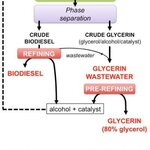Energy

Hydrogen as a fuel source sounds wonderful - its byproduct is water and it releases no CO2. The problem is that compressed hydrogen is scary while uncompressed hydrogen means hauling a container the size of a bus behind your car.
Some people are okay with long charging times and short driving distances for electric cars so if the charging times are eliminated, distance may not be a problem. But adoption is tough - people don't want to buy something before it is viable but it won't become viable until a lot of people buy it. It's the technology variation on the chicken-egg problem.
Hydrogen-XT…

Bright yellow fields of oilseed rape are a common sight at this time of year but what lies beneath is a lot more exciting.
Straw from crops such as wheat, barley, oats and oilseed rape is seen as a potential source of biomass for second generation biofuel production. Currently the UK produces around 12 million tons of straw and much of it is used for animal bedding, mushroom compost and energy generation but there still exists a vast surplus.
Straw contains a mix of sugars that could be used as a source of biofuels that do not compete with food production but instead represent a sustainable…

Wind energy is getting a lot of attention and a lot of money - it just isn't generating a lot of electricity yet, no matter what gets claimed in rosy projections. In the real world, they do quite poorly and building more of them doesn't fix it. Dr. Hui Hu and his group at Iowa State University want to solve a puzzle that has stumped scientists and engineers for hundreds of years; how to make wind work.
Using a large-scale Aerodynamics/Atmospheric Boundary Layer (AABL) Wind Tunnel at Iowa State University, they studied the effects of the relative rotation directions of two tandem wind…

A new fuel-cell concept could allow biodiesel plants to eliminate the creation of hazardous wastes while removing their dependence on fossil fuel from their production process.
The platform, which uses microbes to glean ethanol from glycerol and has the added benefit of cleaning up the wastewater, will allow producers to reincorporate the ethanol and the water into the fuel-making process, said Gemma Reguera, a microbiologist at Michigan State University and co-author of a paper on the subject in
Environmental Science and Technology.
They key is her patented adaptive-engineered bacteria –…
Natural gas has been true boon to emissions. When the rest of the civilized world was adopting more nuclear energy, American politicians representing their constituents were determined to kill it. President Bill Clinton and Senator John Kerry were cheered by their voters when they announced an end to nuclear science in America in the early 1990s. As a result, America built more coal and that led to America leading the world in CO2 emissions.
But in the 2000s, a natural gas revolution took hold. By the end of the first decade, American CO2 emissions were back at early 1990s levels and coal…

There is an optimum size for electrical networks if you want to avoid blackouts - and that does not mean making things better and more redundant.
Being the right size is a common topic in fields like biology. In 1928, geneticist John Haldane wrote the essay "On being the right size" in which he stated that "For every type of animal there is a most convenient size, and a large change in size inevitably carries with it a change of form". This became known as Haldane's Principle.
It applies to power networks also, according to the results of a study done by researchers at Universidad…

Direct current - DC - electricity is used by us every day. If you see a blocky black thing on a power cord, that is a transformer and it turns alternating current (AC) electricity into DC that is used by a device.
In the early days of mass electricity, it was Tesla (and then Westinghouse) versus Edison to create an electricity standard. Edison eventually lost because high-voltage AC electricity meant it could go longer distances - and that meant fewer dirty power plants in city neighborhoods. But the device you are reading this on uses DC power, because it needs to work in a 0 and 1 state and…

Earlier this month, the Epic Electric American Road Trip, a 24-day, 12,183-mile battery-powered journey sponsored by electric vehicle (EV) software and information services company Recargo Inc., was completed.
They expect to be awarded Guinness World Record verification for the longest vehicle journey ever taken using 100% electric power. The goal was to emphasize the possibilities of the nation's current electric vehicle charging infrastructure.
Norman Hajjar, Managing Director of Recargo's driver research division, PlugInsights, crossed the finish line in a stock Tesla Model S sedan.…

Biofuels - ethanol - were trumpeted as being a renewable alternative to fossil fuels for decades. Finally, in 2005, it got the mandates and subsidies environmentalists insisted were necessary to make inroads against a mature industry like petroleum.
Immediately, what scientists knew became evident - they were more resource intensive to produce, were no better for emissions, and subsidies insured there was no reason to get more efficient. Worse, the gold rush of government money drove up corn prices, unfairly impacting the poor.
Another paper has confirmed it was a bad idea, no matter how many…

Researchers have reported a big improvement in the distance of wireless power. Their "Dipole Coil Resonant System (DCRS) boosts the extended range of inductive power transfer up to 5 meters between transmitter and receiver coils.
It's not quite the rumors about Nikola Tesla but if you think that's not a lot, ponder that Bluetooth is only slightly greater after 15 years in progress.
And people want wireless power a lot more than they ever wanted Bluetooth. Since MIT's introduction of the Coupled Magnetic Resonance System (CMRS) in 2007, which used a magnetic field to…